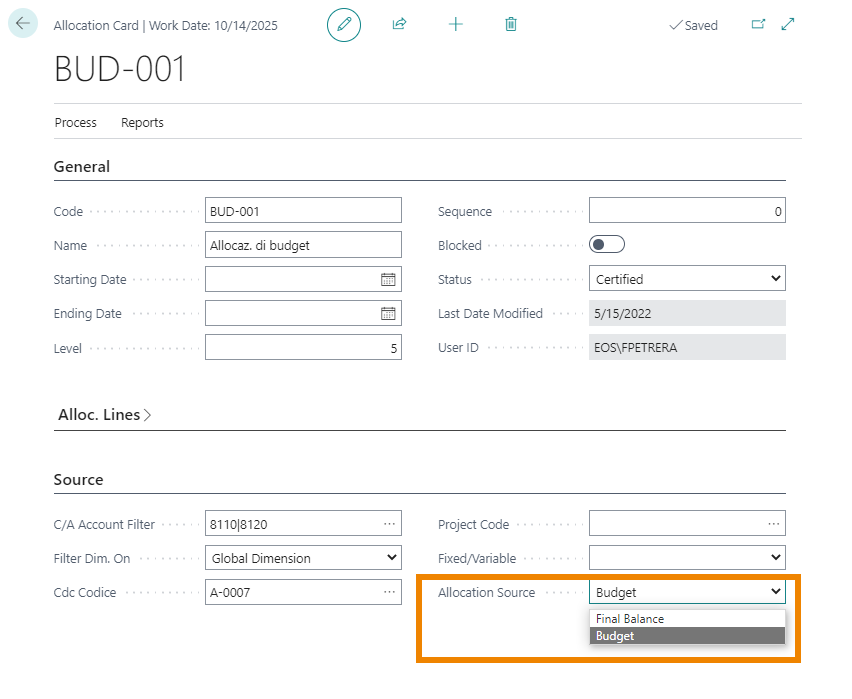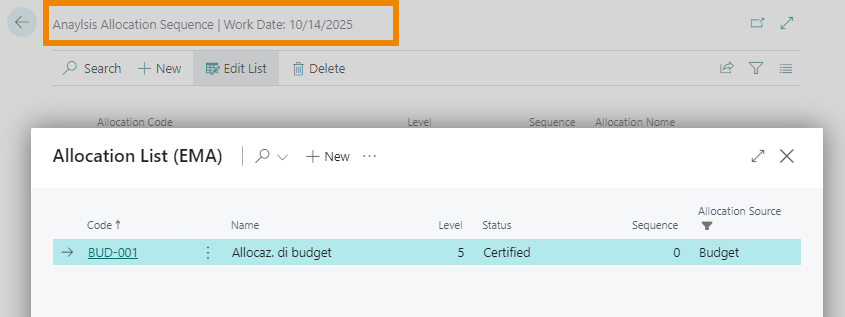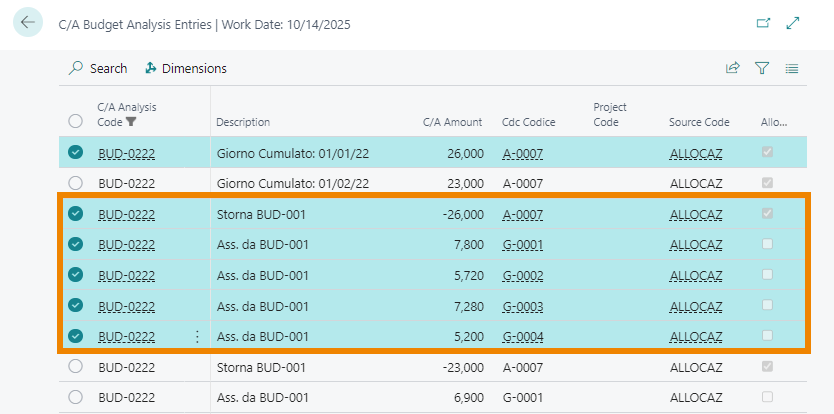Chart of Accounts (EMA)
On the Chart of Accounts of Cost Accounting (of the EMA App), the following flowfields are present:
| Field | Description |
|---|---|
| Budget Amount | Value calculated on the basis of the data in the C/A Budgets for the specific account |
| Analysis Budget Net Change | Value calculated following the budget data allocation process |

Budget C/A
The ability to import the C/A Budget from a specific budget generated within the Power Budget application has been introduced.

Allocation List (EMA)
The “Allocation Card” allows the reversal of indirect costs charged to account/dimensions, to other account/dimension combinations (eg: to Work Centers, Divisions, etc.). As with the allocation of actual data, it is possible to use static and / or dynamic allocations.
On the “Allocations List” and “Allocation Card” pages there is the “Allocation Source” field, containing the following options:
| Field | Description |
|---|---|
| Final balance (default value) | Allows the allocation of cost accounting entries |
| Budget | Allows the allocation of budget data present in the “C/A Budgets (EMA)” |


The different allocation cards are performed in ascending order of level; with the same level, execution takes place according to the “Sequence” field or, alternatively (if the sequence value is equal to zero), according to the Code field (alphanumeric order).
C/A Drivers List (EMA)
The Drivers relating to the allocation of budget data operate with the same logic as the drivers of the EMA App.
Work center / Production area Tariff calculation depending on Production work center
The logic for calculating the budget rates of the individual production area / work center are the same as described in the paragraph relating to the calculation of final rates (EMA APP)
Driver definition
The drivers relating to the allocation of budget data operate with the same logic as the actual ones (EMA App).
Tariff
The calculation logic of the budget rates of the individual production CDCs (Production Areas/Work Centers) is the same as described in the paragraph relating to the calculation of the final rates (EMA App).
Scenario Analysis (EMA)
The logics of use and management of the C/A analysis scenarios are the same as those described in the EMA App.
The installation of EMA Budget Allocation includes the following two fields on the Analysis Scenario page and C/A Analysis Card page:
| Field | Description |
|---|---|
| Allocation Source |
|
| Budget Filter | you can enter this field, if the previous field has the Budget option, to indicate the budget period from which to retrieve the data to be allocated. |


In the case of using the “Allocation Sequence”, it will be possible to insert only allocation cards that have the same value as the “Allocation Source” field.
On the C/A Analysis Card, using the “Update Driver Archive” and then “Update C/A Analysis” functions, it is possible to execute all the allocations that have been entered in the allocation list or only those selected through the " Allocation Sequence ”and then calculate the budget rate of the production cost center.
| Field | Description |
|---|---|
| Update Driver Archive | Updates the performance movements of the drivers encoded on the system |
| Update C/A Analysis | Executes the allocation cards in “Certified” status, in order of Level and Sequence/Code |
Verify data generated through the allocation process
It is possible to open the Chart of C/A directly from the C/A Analysis Card via Related-> Analysis-> Chart of C/A: the latter will already be filtered for the C/A analysis that we have just performed. Alternatively, you can access the " Chart of cost accounts (EMA)” page and apply the appropriate filters:


Through drilldown on the Analysis Budget Net Change" column, it is possible to access the transactions detail, which can also be analyzed through the "Source Traceability" action.

Should a new execution of the same analysis be necessary, it is possible to carry out the appropriate procedures again. In advance you need to reset data generated by the previous allocation.
Feedback
Was this page helpful?
Glad to hear it! Please tell us how we can improve.
Sorry to hear that. Please tell us how we can improve.